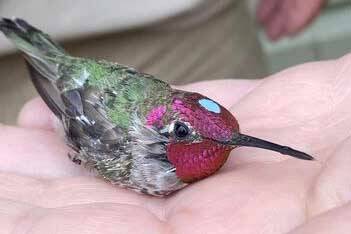In the book “A Sand County Almanac,” Aldo Leopold wrote, “To band a bird is to hold a ticket in a great lottery. Most of us own tickets on our own survival, but we buy them from the insurance company which knows too much to sell us a really sporting chance. It is an exercise in objectivity to hold a ticket on the banded sparrow that falleth, or on the banded chickadee that may someday re-enter your trap, and thus prove he is still alive.”
This quote was one of the things in college that triggered an urge in me to know what happens to birds and where they go.
From past articles, you may know that we have been documenting and banding Anna’s hummingbirds on the Kenai Peninsula since 2018, after they began showing up here 10 years ago. We are hoping to record the first banded bird to overwinter.
Thus far, we haven’t seen banded Anna’s late into the winter. We don’t know if that is because they don’t survive the winter, or they are adapting to not only utilize Alaska in summer but also remain until it is nesting time (December to April), and for some, finding no potential mates, they move on.
In other parts of their range, Anna’s hummingbirds are nonmigratory. However, they still make small movements, often leaving the breeding area and going up in elevation during the nonbreeding times, while others stay put.
On June 23, 2023, we got a report of a hummingbird coming to a feeder near Soldotna High School. We investigated and found it was an adult Anna’s hummingbird. I quickly set up a trap and captured and banded the bird, which can only be done by trained and licensed banders.
It was an adult male that looked extremely rough and disheveled. He was growing in most of his primary feathers, making flight a little difficult. He weighed 5.3 grams, a healthy weight considering the extra energy required to fly with shortened wings.
He represented the 50th Anna’s hummingbird banded on the Kenai and one more chance in the life lottery to see what happens to the birds that disperse to the Kenai Peninsula. The “little guy” stuck around for another week at the house he was visiting and then vanished.
Of the 50 banded over the years, I had only banded one other Anna’s in the summer. The rest I banded in late fall and early winter. I had hoped to get lucky, and the hummingbird with band U23466 would show up in Homer or Seward this fall, and I could at least know where he settled.
It was a complete surprise when one of the other licensed hummingbird banders in the state (there are only three of us) texted me and asked if U23466 was one of my bands.
Kate McLaughlin, with the Alaska Hummingbird Project, lives in Cordova, and she had just caught an adult male with our band on it.
Unlike my encounter, he was now looking perfect and was quite a specimen. Not a feather out of place. He weighed 6.3 grams, which was a full gram heavier. It was the first time a bander discovered one of our banded birds outside of a 3-mile radius from where we banded it.
As with most scientific discoveries, one answer always leads to more questions. We answered where the bird went and that he was still alive. But I have so many more questions that we can only answer with more recoveries like U23466.
Will he stay in Cordova or continue back to where he was born? Where was he born? The current documented northern breeding limit is British Columbia. There is anecdotal evidence that there may be a few birds breeding all the way up to Sitka.
The story of Anna’s hummingbirds on the Kenai Peninsula is still being written. They only started showing up here annually in the last 10 years.
Why did they start dispersing to the Kenai Peninsula? Will they ever start breeding here, or could we actually see the development of a migratory route where young birds spend their first summer on the Kenai but migrate back to their homeland before the next breeding period? Breeding occurs in the Pacific Northwest from December through April.
Studying these various components of our environment has taught me one thing. It is important to understand how and what the different plants and animals do to survive and thrive. It is equally important to recognize that in a changing climate, even the most basic things we knew to be constant can now be outdated.
We cannot always rely on the information we know and learn from there. Some level of confirming our constants is still constant will be essential to protecting what we value the most.
In a few more years, we will likely have transmitters small enough to place on hummingbirds. These transmitters will make the job of answering these complex questions easier. Until then, I will have to continue putting more tickets out there in the form of banded hummingbirds and see where they go.
If you would like to help, report your hummingbird sightings in eBird or email me and tell me about your hummingbird sighting (todd_eskelin@fws.gov).
Todd Eskelin is a Wildlife Biologist at Kenai National Wildlife Refuge. Find more Refuge Notebook articles (1999-present) at https://www.fws.gov/Refuge/Kenai/community/Refuge_notebook.html or other info at http://www.facebook.com/kenainationalwildliferefuge.


